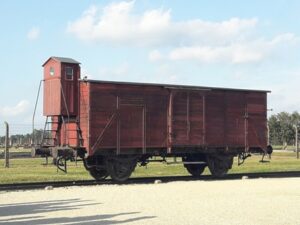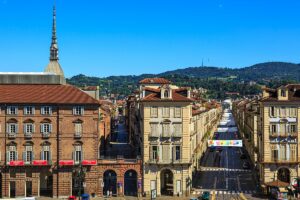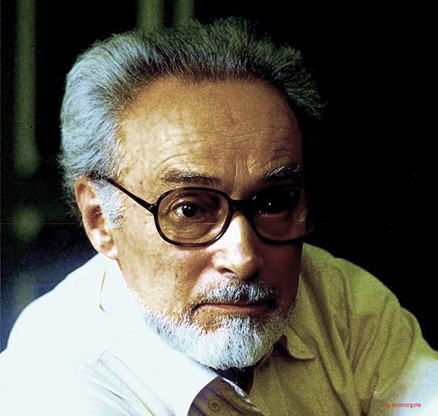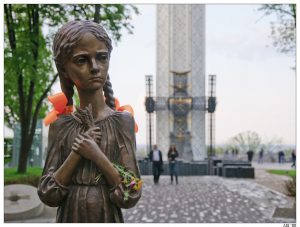In December of 1943, armed and ready to fight for justice, a group known as the Anti-Fascist Partisans had fallen to the powerful forces of the German war machine. Watching this tragedy before his own eyes was an Italian chemist named Primo Levi. By February 21, 1944, Levi was forced into a crowded freight car bound for Auschwitz, the most infamous of the Nazi concentration camps known for slave labor, heinous medical experiments, and death by gas chamber and shooting squads. The freight car was packed with men, women, and children of all ages, including the sick and handicapped, with no amenities, food, or water. Levi’s biographer, Berel Lang explained: “The survival rate started to diminish for the prisoners and escaping led to being shot. People started becoming anxious, knowing their own fate. Levi had seen social injustice before, but Levi ‘s sole purpose…survival.”1

In Turin, Italy, Primo Levi was part of a small Jewish community where he graduated from the University of Turin with a degree in Chemistry. Levi’s diploma was stamped, “Jewish race,” which would prevent him from acquiring a permanent job upon graduating. This was a turning point that led to the imposition of new laws that separated the Jewish race from all other races. The Nazi regime presented an unforgiving choice to most Jews in Europe: hide, resist, or cooperate. This lack of political rights led Levi to flee Turin and join a partisan group of like-minded Jews that formed a resistance to Nazi Fascism. Located in the Piedmont mountains in northern Italy, the Resilience was a rebellious Italian anti-political movement focused on surviving the terror of German forces while waiting for an Allied liberation. Despite his best efforts, Levi and his group were captured and transferred first to Fossoli camp, then to Capri where he would board the Holocaust train to Auschwitz.2 Levi quickly realized that the change from each camp was only for the worse. The journey to Auschwitz was long, with the Jews and others learning to adjust to the poor, inhumane conditions, which would only be the beginning of their torture. Arriving at Auschwitz, Levi reveals in his book, If This is a Man, the visual awareness he had as he approached the front gate. The entryway gate bore the words “Arbeit Macht Frei,” which means “Work makes one free.” Levi knew that the entry into the camp would transform him into a prisoner on the other side of humanity.3
Upon arrival at Auschwitz, Jews stood in long lines for a process known as “selection.” Levi would watch each newly arrived person in front of him learn their fate: labor work, or gas chamber. A doctor would examine each person and with one movement of a hand pointing simple left or right direction, the fate of every person who arrived at Auschwitz was so determined. The selection process ripped families apart and caused loved ones to cry out after being separated from one another. Levi watched as the soldiers stripped each inmate, forced them to wear ragged clothes, and paraded them to their barracks. Unlike eighty percent of most Jews, Levi survived the selection process and was assigned to work at the rubber factory to enhance German transportation. Levi used his knowledge of chemistry and his ability to speak German to secure a position as an assistant chemist in the camp’s laboratory used to make synthetic rubber, a commodity that was in desperate need by the failing Nazi army. This would be one of the key components of his survival.

Levi spent time observing the behavior inside of the camp, such as the relationships among the inmates, and the dispassionate deception and cruelty demonstrated by the Nazi camp guards. Levi described the desperation of the Nazi regime when it came to advancing their military to remain superior to others. The Nazis recruited German adolescents to become the backbone of their army. As part of the youths’ training, they were brought to the concentration camps to view the inmates at Auschwitz. The instructor announced, “These that you see are the enemy of the Reich, your enemies. They are Untermensch; it is only right that they should repair the war damages; these are the people that wanted the war.”4 Adolf Hitler’s theory that whoever holds the hearts of the youth will hold the future had become apparent as Levi witnessed this before his own eyes.
As the day ended, Levi would watch the assembly of other labor units in the square held in the middle of the campground. He realized the most direct way the Nazis would dehumanize the prisoners was by suppressing their names. Constantly, he was called only by his camp number, which was permanently tattooed on his forearm. “Häftling [prisoner]. I have learned that I am a Häftling. My number is 174517; we have been baptized. We will carry the tattoo on our left arm until we die.”5 By tattooing each prisoner, the Nazis created a systemic approach to the process of annihilation. Just as cattle are branded, everyone in Auschwitz was branded for life, and eventually led to slaughter. Levi observed his tattered clothing and realized he had lost his identity, which was yet another face of dehumanization. To keep his clothes clean, Levi joined the communal run to the washroom. This method of “washing” their clothes was ineffective and pointless to Levi. He believed that the act of washing clothes in filthy water without soap serves no purpose. However, he had to put aside his own assumptions, and focus on his health and ultimate survival.
As a man of science, Levi understood that prolonged incarceration would eventually lead to death. The workday started at 4:30 a.m. during the summer months and 5:30 a.m. in the winter months and did not end until sundown. Many times, the men could be seen carrying the corpses of dead inmates who did not survive the day. The meals consisted of watery soup, which would only supply a minimum of 1,300 to 1,700 calories a day. According to Levi’s calculations, death due to starvation would be a minimum of three months.6 As winter months approached, the harsh climate, minimal clothes, and lack of nutrition led to an increased amount of cases of pneumonia, colds, flu, frostbite, and eventually death. In an unfortunate turn of events, Levi hurt his foot while at work and was admitted to the infirmary. Heightened with fear, if he could not recover, he would no longer serve a purpose. The physical discomfort would prove to be unbearable, but with this came the realization that only the strong will survive. Levi was forced to bear the pain in quiet, and he eventually recuperated. While he spent his time in Ka-Be infirmary, he learned of the process of selection to send those no longer able to work to the gas chambers in Birkenau. He found that the belongings of those sent to the gas chambers were used as bartering tools for medical supplies and food to improve prisoners’ quality of life. He learned how to work the system to survive.
The harshness of the winter months at Auschwitz brought death and disease to the dwindling inmate population. On January 11, 1945, Primo Levi developed a fever, headaches, and nausea. He was diagnosed with scarlet fever and once again admitted to the infirmary along with twelve other patients who were experiencing different stages of scarlet fever, diphtheria, or typhus. One week later, on January 18, as the Soviet Red Army was fast approaching, the Germans evacuated Auschwitz leaving the sick behind. By January 27, the Soviet Army entered the camp and set up a temporary hospital to care for the remaining survivors. Levi was only one of the hundreds of patients that survived the illness, cold, and hunger, before the arrival of the Russian liberators.7 Unexpectedly, Levi survived thanks to his illness. Thousands had been executed in the camps prior to the death marches and another 15,000 died during the marches due to the cold, or shot by the SS for falling behind, or by starvation. Levi managed to survive by chance.

Upon the liberation of Auschwitz by the Soviets in 1945, Levi made the long trip back to his hometown of Turin, Italy, where in 1961 he became the General Manager of a factory that produced enamels, paints, and synthetic resins. After his 30-year career in manufacturing, Levi pursued his passion for writing. He believed that documenting his experience would bear witness to the actions of the Nazis and their atrocities during his time spent at Auschwitz but, surprisingly his book, If This is a Man, was denied by Einaudi, the local publishing house. The manuscript was eventually sold to a small publishing house, De Silva, but upon publication, it did not produce much interest. Publishers perceived the book to be too difficult to market due to the serious subject matter in a depressing post-war era. Many survivors were not interested in reliving the traumatic past and society desired to move forward rather than dwell on the dreadful past.8 However, Primo Levi believed it was imperative to keep the memory of the Holocaust alive because the danger that people will be lured down a similar path is always present, and it was important to prevent history from repeating itself. After a failed attempt at publication, Levi decided to focus on family, marrying Lucia Morpurgo, and having two children.
It wasn’t until ten years later that the general population began to show interest in Levi’s experience during the Holocaust. After much attention, Levi revisited Einaudi Publishing House, and this time he was successfully published. He went on to publish two volumes of short stories in the science fiction genre. In a 1963 sequel to If This is a Man, Levi published The Truce, detailing his long journey by train back to his home after his liberation from Auschwitz and the displacement of Jews and aftermath of war. When approaching retirement, Levi returned to autobiographies and wrote, The Periodic Table in 1975, a collection of twenty-one meditations, each named after a chemical element covering everything from his childhood and schooling to life after Auschwitz. The success of The Periodic Table led to a speaking tour in the United States. Levi then published The Drowned and the Saved, which was his last book.
On April 11, 1987, the Concierge at the hotel where Levi had lived before and after his time in Auschwitz, found him dead at the bottom of a stairwell. After much speculation about the cause of death, the coroner ruled his death as suicide. Close friends of Levi believed it was suicide caused by the suffering he endured decades earlier and the high personal cost of bearing witness and reliving these events through his writings. Others, including his personal doctor, believed it was an accident as he suffered from dizzy spells. His death remains a controversial topic to this day. Levi left a legacy as one of the most important Holocaust writers and has been the subject of many biographies and documentaries. In 2006, his book, The Periodic Table, was noted by London’s Royal Institution as one of the best science books ever written. The Truce was made into a movie starring John Torturro, and in 2001, the movie The Grey Zone, was based on the final chapter of The Drowned and the Saved. Levi died with a legacy and will never be forgotten for telling his story of how he survived the most ruthless Death Camp the world has ever known.
- Berel Lang, Primo Levi: The Matter of a Life, Jewish Lives (New Haven: Yale University Press, 2013), 5. ↵
- Berel Lang, Primo Levi: The Matter of a Life, Jewish Lives (New Haven: Yale University Press, 2013), 18 ↵
- Sharon Portnoff, “Levi’s Auschwitz and Dante’s Hell,” Society 46, no. 1 (January 1, 2009): 9 ↵
- Gabriel Motola, “Primo Levi: The Auschwitz Experience,” The Southwest Review 72, no. 2 (1987): 260 ↵
- Michael Tager, “Primo Levi and the Language of Witness,” Criticism 35, no. 2 (1993): 268. ↵
- Berel Lang, Primo Levi: The Matter of a Life, Jewish Lives (New Haven: Yale University Press, 2013), 33. ↵
- JoAnn Cannon, “Storytelling and Picaresque in Levi’s La Trengua,” Modern Language Studies 31, no.2 (2001): 1. ↵
- Fausto Galuzzi, “Primo Levi,” Oral History 16, no.2 (1998): 20 ↵


